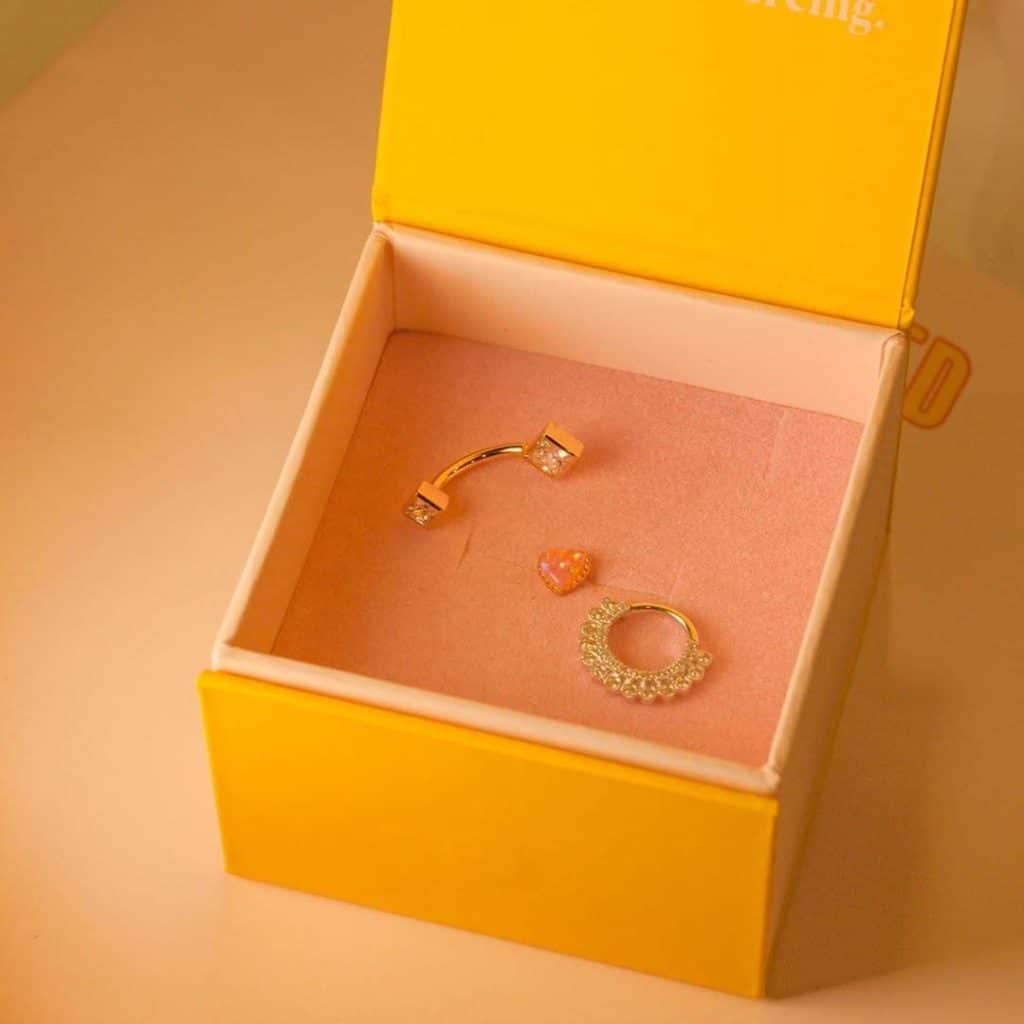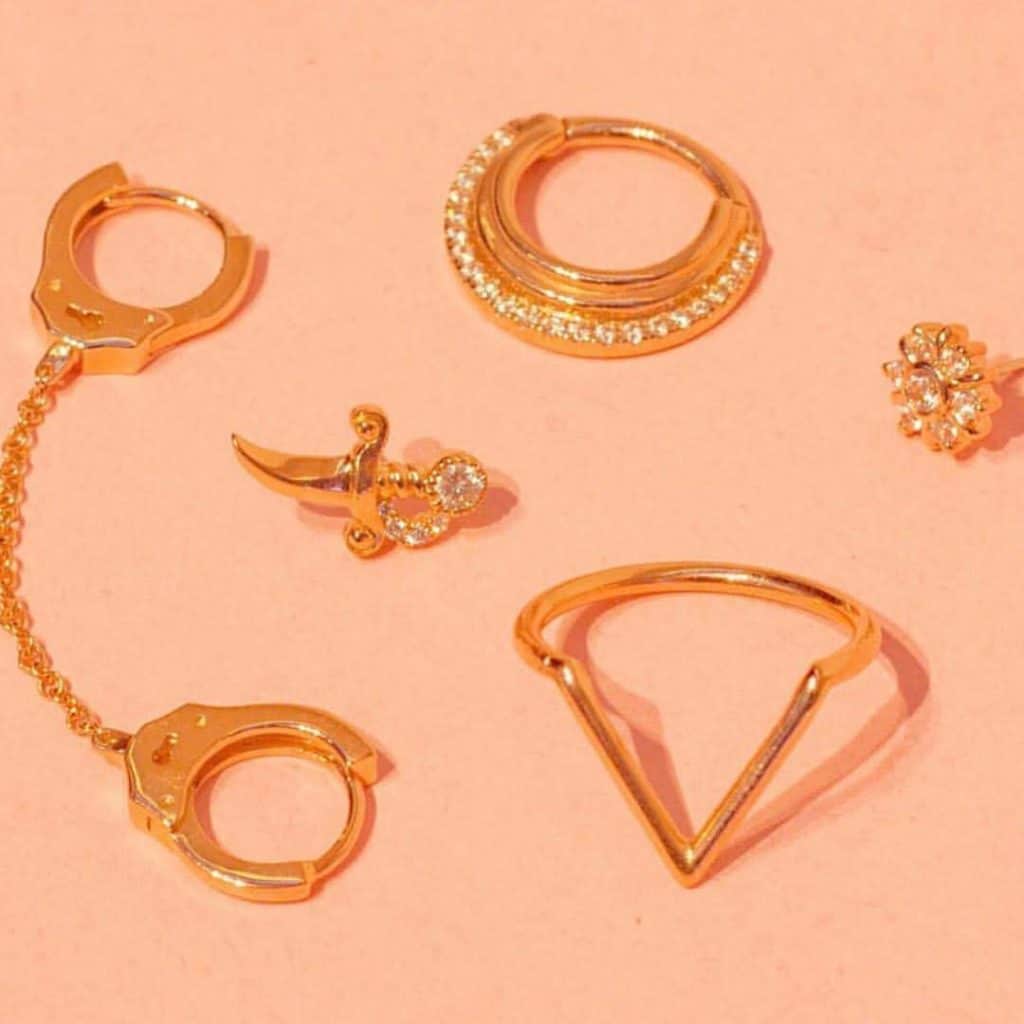What is body piercing jewelry made of?
Piercing jewelry is usually made of some type of metallic alloy that isn’t harmful to the skin. This is typically gold with varying carat weights, from 18-24. The alloy aspect of these metals shows how much of another metal, such as nickel or silver, is used. Some lower quality, cheaper jewelry is made out of inexpensive alloys that can cause irritation or rash, such as zinc or copper, so make sure you invest in higher quality goods if you can. If you have a known allergy to these metals, stay away from them. Most allergic reactions start out as slight itchiness or irritation, so pay attention to the area of your skin that you had work done on in order to prevent this. If you see any redness, swelling, or feel pain or itchiness, take the jewelry out immediately. If you have any concerns, speak to your artist about any possible alternatives that will make the process easier for you.
What is the best metal for Body Piercing Jewelry?
Depending on the type and area of piercing, different grades and forms of metal are recommended in order to prevent irritation and infection. There are also consistently used metals that offer the best in protection and durability.Stainless Steel (Surgical)
Most piercings, regardless of the general area, will be stainless steel applications. Almost all body jewelry is made out of this metal due to its sheen, durability, and the fact that it is hypoallergenic. On top of that, it’s much more affordable than gold or titanium, and tends to fit in better with clothing and other accessories. Implant-grade stainless steel used for body piercings will be certified as 316 LVM or 316L, so be on the lookout for those numbers when you go to get work done. Also be aware that if you have a nickel allergy, you should choose a different metal, as a small amount is present in stainless steel.Gold:
Gold will always remain timeless, expensive, and sought after no matter where or how it is worn. For piercings, this soft, malleable metal is often used with a stronger alloy metal, such as copper, in order to help it withstand the rigors of daily wear. Ensure that you don’t have a copper allergy if this is the case, as even with plated metals sensitivities may create irritation. Pure gold is always stamped and certified as 24k, and contains no other alloy metals.
Titanium:
Certified titanium is a tough, heavy duty metal that makes it a good choice for the nose area. You’ll need to make sure that you’re getting an implant-grade or implant-certified titanium piercing when you get work done, since the metal is not naturally compatible with being around skin. In spite of this, titanium is durable and light, making it ideal for long term piercing applications.Materials to Stay Away from:
If you’re going with a respected, well-known shop for your piercing, you won’t need to worry about running into these materials for your body jewelry, but it pays to know what to watch out for just in case.Nylon or Plastic:
The brittle nature of plastic makes it the worst choice for any sort of piercing application. The natural porousness of plastic also means that it soaks up bacteria, dirt, and other nasty things throughout the day, making it difficult or impossible to clean. Instead of worrying about cleaning it all the time, you can spend just a bit more money and have a much more hygienic piercing experience.Some Alloy Metals and Sterling Silver:
Any metals that have other metals within them, either for aesthetics or durability, makes them an alloy. This can also create an environment where people with sensitive skin can get nasty allergies. Thus, it’s a good idea to talk with your piercing artist about everything that’s going to be in your piece. Sterling silver is essentially silver alloy, typically with zinc or nickel. You can actually be allergic to the silver itself, as well as having it tarnish against your skin. It will oxidize when exposed to the air, fluids, and sweat, leaving a semi-permanent black stain on your skin. You should only use sterling silver pieces if you know you won’t have a reaction with any of the alloy metals, and if you are switching out from an older piercing type.How do I clean my piercing jewelry?
Worrying about cleaning your jewelry doesn’t have to make you anxious, and it will not only stop infections from occurring but also extend the life of your piercing. When you take your jewelry out, wash it with antibacterial soap and warm water, just as you would with your hands. Remove and noticeable debris if you can see or feel it, and try to time it for at least three minutes to ensure everything is clean and disinfected.
Common Piercings and Their Types of Jewelry:
There are many different ways and trends in body piercing for both men and women, but here are some of the most widely known and practiced forms:Belly Button:
The stomach area is a fun area for a piercing, especially in warmer weather where more people will see it with a crop top or bathing suit. Everything from twisted barbells to bead rings is fair game. These are typically made from stainless steel, though they can vary with different colors and styles.Nose Rings:
Nose rings are timeless for their unique quality and “in your face” approach. They draw the viewer to your face, and hopefully, a really cool piercing. Most rings are made from stainless steel, but can also vary with gold materials, almost like a bull’s ring.Lip Rings:
A lip ring is a seductive, personal piercing that is typically made from stainless steel. These types of piercings are popular among all age groups and genders, and have varying levels of designs and looks, whether offset or centered, pairing well with different lipsticks or makeup.Ready to Explore our selection of jewelry?
At Chronic Ink Tattoo, our talented piercers are ready to help you explore the vast jewelry options to make sure you find something you’ll want to show off for decades to come. If you’re in the Toronto, Markham, Mississauga, Kitsilano Vancouver area drop by our shop and check us out for yourself.
Tell us Your IdeaTattoo Studio Locations
Downtown Toronto
378 Yonge Street, 2nd Floor, Toronto, Ontario M5B 1S6 Directions
Midtown Toronto
252 Eglinton Ave East, 2nd Floor, Toronto, Ontario M4P 1K2 Directions
Markham
7381 Kennedy Road, Unit #105, Markham, Ontario L3R 5B5 Directions
Mississauga
100 City Centre Dr., Unit #2-311, Mississauga, Ontario L5N 2C9 Directions
Vancouver
1804 W 4th Ave, Vancouver, British Columbia V6J 1M3 Directions
Looking for your next Tattoo Idea?
Browse our selection of one of a kinda tattoo designs created by our Chronic Ink artists. Each piece is individual and will only ever be tattooed once.


